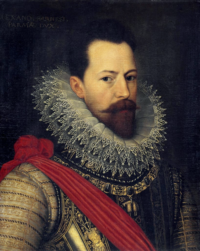
Frederick Henry was the sovereign prince of Orange and stadtholder of Holland, Zeeland, Utrecht, Guelders, Overijssel in the Dutch Republic from 1625 until his death in 1647. In the last seven years of his life, he was also the stadtholder of Groningen (1640-1647).

A Spanish Fury was a number of violent sackings of cities in the Low Countries or Benelux, mostly by Spanish Habsburg armies, that happened in the years 1572–1579 during the Dutch Revolt. In some cases, the sack did not follow the taking of a city. In others, the sack was ordered, or at least not restrained, by Spanish commanders after the fall of a city.

The siege of Maastricht was fought between 9 June and 22 August 1632, when the Dutch commander Frederick Henry, Prince of Orange, eventually captured the city from Habsburg forces.
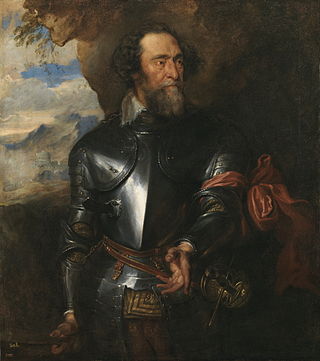
Hendrik van den Bergh, 1573 to 22 May 1638, was a Flemish noble and professional soldier. Hereditary lord of Stevensweert, from 1618 to 1637 he was also stadtholder of Upper Guelders, the only part of Guelders to remain loyal to Habsburg Spain during the Eighty Years War. Known as a brave and resourceful cavalry commander, he spent most of his career with the Spanish Army of Flanders and became its Maestre de campo in 1628. Accused of treachery after the loss of Den Bosch in 1629, he defected to the Dutch Republic following the 1632 Conspiracy of Nobles.
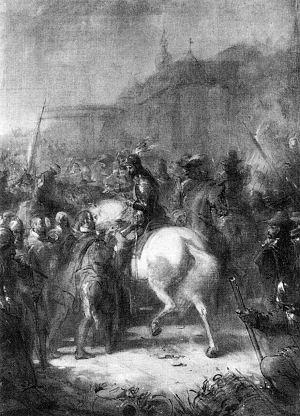
The fourth siege of Breda was an important siege in the Eighty Years' War in which stadtholder Frederick Henry, Prince of Orange retook the city of Breda, which had last changed hands in 1625 when the Spanish general Ambrogio Spinola conquered it for the Spanish Habsburgs. Hereafter, the city would remain in the hands of the Dutch Republic until the end of the war.

The siege of Venlo was an important siege in the Eighty Years' War that lasted from 20 to 25 August 1637. The Cardinal-Infante Ferdinand of Austria, Governor of the Spanish Netherlands, retook the city of Venlo from the United Provinces, which had taken control of it in 1632 during the offensive of Frederick Henry, Prince of Orange against Maastricht. The capture of Venlo and Roermond, which was surrendered to the Cardinal-Infante a week later, effectively cut Maastricht from the Dutch Republic, thus preventing further attacks on the Spanish Netherlands from the east. In the southern front Ferdinand lost the towns of La Capelle, Landrecies, and Damvillers to the French, but then he forced them to retreat south of Maubeuge.

The siege of Eindhoven, also known as the capture of Eindhoven of 1583, took place between 7 February and 23 April 1583 at Eindhoven, Duchy of Brabant, Spanish Netherlands during the Eighty Years' War and the Anglo-Spanish War (1585–1604). On 7 February 1583 a Spanish force sent by Don Alexander Farnese, Governor-General of the Spanish Netherlands, commanded by Karl von Mansfeld and Claude de Berlaymont, laid siege to Eindhoven, an important and strategic city of Brabant held by Dutch, Scottish, and French soldiers under the States' commander Hendrik van Bonnivet. After three months of siege, and the failed attempts by the States-General to assist Bonnivet's forces, the defenders surrendered to the Spaniards on 23 April.

The Battle of Steenbergen, also known as the Capture of Steenbergen of 1583, took place on 17 June 1583 at Steenbergen, Duchy of Brabant, Spanish Netherlands. This was an important victory for the Spanish Army of Flanders led by Don Alexander Farnese, Prince of Parma, Governor-General of the Spanish Netherlands, over the French, English, and Dutch forces led by the French Marshal Armand de Gontaut, Baron de Biron, and the English commander Sir John Norreys, during the Eighty Years' War, the Anglo-Spanish War (1585–1604), and in the context of the French Wars of Religion. The victory of the Spaniards ended the Treaty of Plessis-les-Tours, and Francis, Duke of Anjou (French: François de France), left the Netherlands in late June.
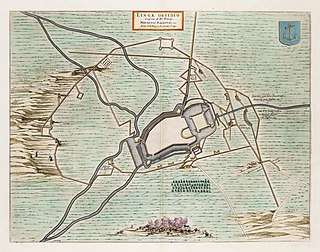
The siege of Lingen took place during the Eighty Years' War and the Anglo–Spanish War by a Dutch and English army led by Maurice of Orange. Frederik van den Bergh defended Lingen for Philip II of Spain which was besieged from 25 October 1597. After a siege of more than two weeks, Van den Bergh surrendered on 12 November 1597. The siege was part of Maurice's successful 1597 campaign against the Spaniards.

The siege of Oldenzaal was a short siege that took place during the Eighty Years' War and the Anglo–Spanish War by a Dutch and English army led by Maurice of Orange of the city of Oldenzaal from 20 to 23 October 1597. The city surrendered to the overwhelming Dutch and English force. The siege was part of Maurice's campaign of 1597 known as the Ten Glory Years, his highly successful offensive against the Spaniards.

The siege of Meurs took place between 29 August to 3 September 1597 during the Eighty Years' War and the Anglo–Spanish War. The Spanish occupied city of Moers under Governor Andrés de Miranda was besieged by Dutch and English troops under the command of Prince Maurice of Orange. The siege ended with the capitulation and the withdrawal of the Spanish garrison. The siege was part of Maurice's campaign of 1597 known as the Ten Glory Years, his highly successful offensive against the Spaniards.

The siege of Rheinberg took place from the 9 to 19 August 1597 during the Eighty Years' War and the Anglo–Spanish War by a Dutch and English army led by Maurice of Orange. The siege ended with the capitulation and the withdrawal of the Spanish after much unrest in the garrison. The liberation of the city of Rheinberg was the commencement of Maurice's campaign of 1597, a successful offensive against the Spaniards during the period known as the Ten Glory Years.

The Capture of Ootmarsum in 1597 was a short siege, that took place during the Eighty Years' War and the Anglo–Spanish War by a Dutch and English army led by Count Van Duivenvoorde while Maurice of Nassau was besieging Oldenzaal. The siege lasted from 19 to 21 October, where the Spanish garrison of Ootmarsum under the governor, Otto Van Den Sande, surrendered and was then occupied by the besiegers. The siege was part of Maurice's successful offensive against the Spaniards during the same year.

The siege of Grave, also known as the capture of Grave of 1586, took place from mid-February to 7 June 1586 at Grave, Duchy of Brabant, Low Countries, between the Spanish army led by Governor-General Don Alexander Farnese, Prince of Parma, and the Dutch-States and English forces under Baron Peter van Hemart, Governor of Grave, during the Eighty Years' War and the Anglo-Spanish War (1585–1604).
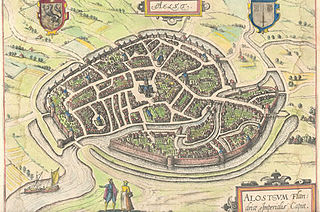
The Capture of Aalst of 1584, also known as the Betrayal of Aalst, took place in early February, 1584, at Aalst, County of Aalst, Flanders, during the Eighty Years' War and the Anglo-Spanish War (1585–1604). In 1584, after the successful Spanish military campaign of 1583, the Governor-General Don Alexander Farnese, Prince of Parma, was focused in subjecting by hunger the cities located on the Scheldt and its tributaries. One of these cities was Aalst, located on the Dender river. In January, the garrison of Aalst, composed of English troops under the command of Governor Olivier van den Tympel, was surrounded and blocked by the Spanish forces led by Parma. In this situation, the English soldiers, tired of the lack of supplies and pay, finally surrendered the city to Parma, in exchange for 128,250 florins and entered the service of the Spanish army.

The siege of Venlo of 1586, also known as the Capture of Venlo, was a Spanish victory that took place on June 28, 1586, at the city of Venlo, in the southeastern of Low Countries, near the German border, between the Spanish forces commanded by Governor-General Don Alexander Farnese, Prince of Parma, and the Dutch garrison of Venlo, supported by relief troops under Maarten Schenck van Nydeggen and Sir Roger Williams, during the Eighty Years' War and the Anglo-Spanish War (1585–1604). After two failed attempts to relieve the city, the siege ended on June 28, 1586, with the capitulation and the withdrawal of the Dutch garrison.
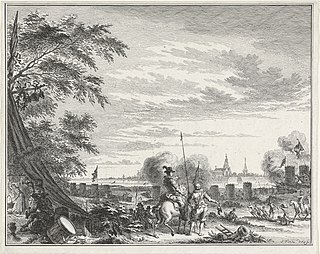
The siege of Grave was a siege that took place between 18 July and 20 September 1602, as part of the Eighty Years' War and the Anglo–Spanish War. The Spanish-held city of Grave was besieged by a Dutch and English army led by Maurice of Orange and Francis Vere respectively. After a siege of nearly two months the city surrendered when a Spanish relief army under Francisco de Mendoza was defeated just outside the city by the besiegers. The defeat was severe enough to cause a major mutiny in the Spanish army.
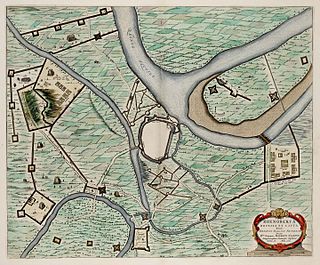
The siege of Rheinberg, also known as the Rhine campaign of 1601, was the siege of the towns of Rheinberg and Meurs from 12 June to 2 August 1601 during the Eighty Years' War and the Anglo–Spanish War. Maurice of Orange with an Anglo-Dutch army besieged the Spanish-held cities in part to distract them before their impending siege at Ostend. Rheinberg, an important city, eventually capitulated on 28 July after a Spanish relief force under Herman van den Bergh failed to relieve the city. The towns of Meurs surrendered soon after.
The Capture of Roermond was a minor siege during the Eighty Years' War which took place from the 31st of August to the 1st of September, 1637. A Spanish army under Cardinal-Infante Ferdinand would successfully siege and seize Roermond from the Dutch just one week after his victory at Venlo. This siege battle and that of Venlo were originally targeted to draw Frederick Henry away from Berda and towards the Cardinal-Infante's army for what could've been a field battle. Frederick Henry wouldn't be swayed by this attempt and was dedicated to sieging Breda and would eventually take it on the 11th of October.

The siege of Venlo was an 12-day siege of the city of Venlo commenced by the Grand Alliance which saw the city being taken after being occupied by French troops the year before. The siege of Venlo in 1702 was one of many sieges that Venlo had endured throughout its history.

